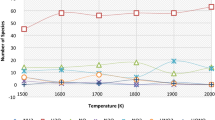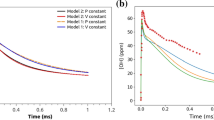Abstract
The study of the combustion property of newly designed propellant by means of computational simulation is an efficient pathway for assessment and could avoid exposure to hazardous chemicals. An RDX-modified triple-base solid propellant formula was proposed in this study. Reactive molecular dynamics simulations employing ReaxFF-lg force field were performed to explore the thermal decomposition property of the propellant for a variety of temperatures. The reaction kinetics of the system and major ingredients were analyzed, and the apparent decomposition activation energies were calculated. The population of decomposition intermediates and products is thoroughly investigated. H2O is consumed at high temperatures indicating a water–gas reaction that could reduce carbon clusters during the combustion of solid propellant. The water–gas reaction, as well as the population of H2 at high temperature, points out the way of adjusting the formula of the propellant, which is adding fuel and oxidizer to improve combustion temperature and oxygen balance.
Graphical abstract






Similar content being viewed by others
Data availability
All data generated or analyzed during this study are included in this published article.
Code availability
The large-scale atomic molecular massively parallel simulator (LAMMPS) version 29 Sep 2021 was used.
References
Agrawal JP (2010) High energy materials: propellants, explosives and pyrotechnics. John Wiley & Sons
Klapötke TM (2017) Chemistry of high-energy materials [M]. de Gruyter
Ashraf C, Jain A, Xuan Y et al (2017) ReaxFF based molecular dynamics simulations of ignition front propagation in hydrocarbon/oxygen mixtures under high temperature and pressure conditions. Phys Chem Chem Phys 19(7):5004–5017
Chen Z, Sun W, Zhao L (2019) Initial mechanism and kinetics of diesel incomplete combustion: ReaxFF molecular dynamics based on a multicomponent fuel model. J Phys Chem C 123(14):8512–8521
Wang F, Chen L, Geng D et al (2020) Chemical reactions of a CL-20 crystal under heat and shock determined by ReaxFF reactive molecular dynamics simulations. Phys Chem Chem Phys 22(40):23323–23332
Xiong Y, Ma Y, He X et al (2019) Reversible intramolecular hydrogen transfer: a completely new mechanism for low impact sensitivity of energetic materials. Phys Chem Chem Phys 21(5):2397–2409
Xue X, Ma Y, Zeng Q et al (2017) Initial decay mechanism of the heated CL-20/HMX cocrystal: a case of the cocrystal mediating the thermal stability of the two pure components. J Phys Chem C 121(9):4899–4908
Song L, Zhao FQ, Xu SY et al (2021) Encapsulating aluminum nanoparticles into carbon nanotubes for combustion: a molecular dynamics study. Phys Chem Chem Phys 23(20):11886–11892
Hong S, van Duin ACT (2015) Molecular dynamics simulations of the oxidation of aluminum nanoparticles using the ReaxFF reactive force field. J Phys Chem C 119(31):17876–17886
Valencia FJ, Hernandez-Vazquez EE, Bringa EM et al (2018) Growth of Ni nanoclusters on irradiated graphene: a molecular dynamics study. Phys Chem Chem Phys 20(24):16347–16353
Liu L, Liu Y, Zybin SV et al (2011) ReaxFF-lg: Correction of the ReaxFF reactive force field for London dispersion, with applications to the equations of state for energetic materials. J Phys Chem A 115(40):11016–11022
Larentzos JP, Rice BM (2017) Transferable reactive force fields: extensions of ReaxFF-lg to nitromethane. J Phys Chem A 121(9):2001–2013
Mei Z, An Q, Zhao FQ et al (2018) Reactive molecular dynamics simulation of thermal decomposition for nano-aluminized explosives. Phys Chem Chem Phys 20(46):29341–29350
Meng J, Zhang S, Gou R et al (2020) The thermal decomposition process of composition B by ReaxFF/lg force field. J Mol Model 26(9):1–11
Zhao J, Xiao Y, He J et al (2022) Reactive molecular dynamics simulations on thermal decomposition of 3-methyl-2, 6-dinitrophenol. J Mol Model 28(2):1–7
Wang XK, Zhao Y, Zhao FQ et al (2020) Reactive molecular dynamics simulation of thermal decomposition for nitromethane/nano-aluminum composites. J Mol Model 26(11):1–9
Plimpton S (1995) Fast parallel algorithms for short-range molecular dynamics. J Comput Phys 117:1–19
Rice BM, Mattson WD, Larentzos JP et al (2020) Heuristics for chemical species identification in dense systems. J Chem Phys 153(6):064102
Strachan A, Kober EM, Van Duin ACT et al (2005) Thermal decomposition of RDX from reactive molecular dynamics. J Chem Phys 122(5):054502
Boschan R, Merrow RT, Van Dolah RW (1955) The chemistry of nitrate esters. Chem Rev 55(3):485–510
Harris NJ, Lammertsma K (1997) Ab initio density functional computations of conformations and bond dissociation energies for hexahydro-1,3,5-trinitro-1,3,5-triazine [J]. J Am Chem Soc 119(28):6583–6589
Chen L, Wang H, Wang F et al (2018) Thermal decomposition mechanism of 2,2′,4,4′,6,6′-hexanitrostilbene by ReaxFF reactive molecular dynamics simulations. J Phys Chem C 122(34):19309–19318
Kashiwaya Y, Ishii K (1993) Water gas reaction in coke gasification by H2O. Hokkaido Daigaku Kogakubu Kenkyu Hokoku. Bulletin of the Faculty of Engineering, Hokkaido University, Japan, p 162
Funding
J. Yi and Z. Guo were supported by the National Natural Science Foundation of China with Grant Nos. 22075226, and 21504067, respectively.
Author information
Authors and Affiliations
Contributions
Z. Guo and J. Yi conceived and designed the study. J. Yi and H. Ma performed simulations. Z. Guo wrote the paper. Z. Qin, H. Li, and F. Zhao analyzed data and plotted figures. All authors read and approved submission of the manuscript.
Corresponding author
Ethics declarations
Conflict of interest
The authors declare no competing interests.
Additional information
Publisher's note
Springer Nature remains neutral with regard to jurisdictional claims in published maps and institutional affiliations.
Supplementary Information
Below is the link to the electronic supplementary material.
Rights and permissions
About this article
Cite this article
Yi, J., Qin, Z., Li, H. et al. Reactive molecular dynamics study on the thermal decomposition reaction of a triple-base solid propellant. J Mol Model 28, 216 (2022). https://doi.org/10.1007/s00894-022-05203-x
Received:
Accepted:
Published:
DOI: https://doi.org/10.1007/s00894-022-05203-x




